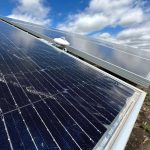Solar garden has the ability to provide power for about 600 homes
La Plata Electric Association Board of Directors President Ted Compton ceremoniously cuts a ribbon signifying the completion of construction on the Sunnyside Community Solar Garden south of Durango. (Tyler Brown/Durango Herald)
Beginning in July, La Plata Electric Association will start taking subscription applications for its Sunnyside Community Solar Program.
The power cooperative celebrated the construction of its first community solar project with a ribbon-cutting ceremony on Wednesday. The solar garden, north of Sunnyside Elementary School south of Durango, occupies 9.4 acres of a 55-acre property, making it the largest array in the county.
It will have the ability to generate power for about 600 homes and provide 22,000 100-watt shares.
“It’s probably been at least 10 years that we’ve been eyeing this property,” said Dan Harms, LPEA vice president of grid solutions, adding that ever since the power co-op built a substation on that property, leadership felt it was the perfect place to build a solar garden.
LPEA made headlines in March when it voted to withdraw from its contract with Tri-State Generation and Transmission Association, its wholesale energy provider.
The move was made in part so the co-op could seek clean energy opportunities like solar projects.
The goal is for the co-op to be completely self-powered by 2026 when LPEA officially cuts ties with the power wholesaler, Harms said on Wednesday.
“I see this project as a game changer. It’s really not just about flipping the switch on solar panels. I see it more as flipping the script on how we supply power to our community,” said LPEA Board of Directors President Ted Compton.
The solar panels are single-axis which means they maneuver to follow the sun’s position throughout the day.
The solar garden was built by Durango-based Konisto Companies, LLC, and has 3,623 total panels. The project was primarily funded by a $13.4 million loan issued by the U.S. Department of Agriculture.
La Plata County, a prominent anchor tenant for the project, also invested $2 million into the solar garden.
“This project is very important for the future of clean energy in La Plata County and I applaud LPEA for initiating it,” said La Plata County Commissioner Marsha Porter-Norton. “The taxpayers of La Plata County get an excellent return on investment and the $2 million eventually comes back to the County’s coffers. This is a win-win-win if ever there was one.”
Enrolled members will receive credits on their electric bills based on the number of kilowatt-hours produced by their subscription each month, starting in October 2024.
The power cooperative hopes to have the solar panels functioning by July but has not set a specific date as to when the solar garden will be fully operational. LPEA is still working through paperwork regarding metering and tax credits.
The application period opens on July 1 and will be accepted through Aug. 29. If demand exceeds subscription supply, applications will move to a lottery system, the co-op said in a news release Wednesday.
One of the significant aspects of the project is its income-qualified program, which will offer 50% of the power to LPEA members who make less than the 80% area median income.
LPEA Energy Management Adviser Emily Missildine said that 80% area median income equals about $88,000 per year for a family of four.
Harms said the income-qualified member will receive a 20% discount on energy rates. These savings will be administered through LPEA but funded through the Inflation Reduction Act and not the cooperative.
This post was originally published on 3rd party site mentioned in the title of this site





